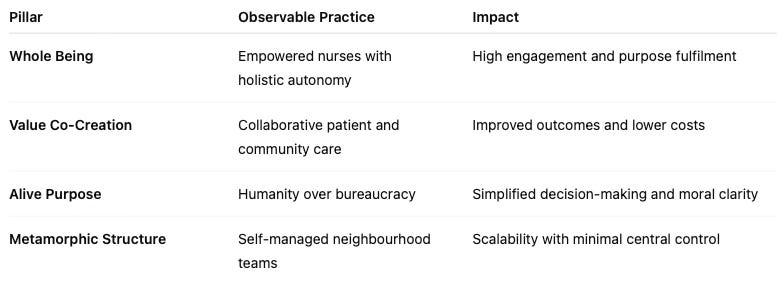Buurtzorg - Case Study
Reinventing Healthcare Through Self-Management and Human-Centred Design
Context and Overview
Buurtzorg (Dutch for “Neighbourhood Care”) was founded in 2006 by Jos de Blok, a nurse frustrated by the bureaucracy and fragmentation of traditional home care systems in the Netherlands. What started as a small experiment with a single team of nurses has grown into a national and international movementemploying over 15,000 professionals and inspiring healthcare models in more than 25 countries.
Buurtzorg offers a blueprint for how Alive Organisations can operate in the public and social sectors — combining human autonomy, trust, and purpose with simple, adaptive structures.
Its model delivers both exceptional patient outcomes and superior employee satisfaction, while operating at 30–40% lower overhead than conventional healthcare providers.
1. Whole Being – The Human at the Centre
Buurtzorg is built entirely around human wholeness — for both caregivers and patients. Its design starts from a deeply human premise: people want to take responsibility for meaningful work when they are trusted to do so.
Core practices that nurture Whole Being:
Self-Managed Teams: Nurses work in small, autonomous neighbourhood groups of 10–12 members.
Holistic Care Philosophy: Nurses manage both medical and social dimensions of care — building long-term relationships with patients.
No Middle Management: Teams self-coordinate using digital tools, with access to peer coaches instead of supervisors.
Emphasis on Meaning and Dignity: Professional fulfilment is valued as highly as efficiency or output.
This structure restores professional autonomy and intrinsic motivation, creating a system where people thrive by being whole.
2. Value Co-Creation – Care as a Collaborative Network
Buurtzorg redefines value creation in healthcare as a co-created process among patients, families, communities, and professionals.
Examples of co-creation in practice:
Patients as Partners: Care plans are developed collaboratively with patients and families, respecting local context and autonomy.
Community Integration: Teams engage neighbourhood resources — volunteers, social workers, and local networks — in the care process.
Technology-Enabled Collaboration: The BuurtzorgWeb digital platform allows teams to share best practices, coordinate care, and continuously learn.
External Ecosystem: Cooperation with municipalities and healthcare insurers to design integrated, preventive care pathways.
By redefining patients as participants rather than recipients, Buurtzorg demonstrates Value Co-Creation Practices rooted in empathy and shared accountability.
3. Alive Purpose – “Humanity over Bureaucracy”
Buurtzorg’s purpose statement is simple yet profound:
“Humanity over bureaucracy.”
This Superior Purpose challenges the prevailing logic of efficiency and standardisation in healthcare.
Purpose activation mechanisms:
Clear Ethical Compass: Every decision is guided by what best serves patients and communities, not what is easiest administratively.
Cultural Reinforcement: Purpose is not enforced through policies, but lived daily through relationships and trust.
Societal Foresight: Buurtzorg actively shapes the future of healthcare through dialogue with policymakers, advocating for system redesign around human needs.
Replicability as Influence: The model is openly shared internationally, showing that purpose can scale without control.
Alive Purpose in Buurtzorg is both moral and practical — it simplifies complexity by focusing on what truly matters.
4. Metamorphic Structure – Self-Management as Living Architecture
Buurtzorg’s self-organising structure is one of the most mature examples of Metamorphic Organisation Design. It demonstrates how large-scale systems can operate without hierarchy, sustained by trust, technology, and shared purpose.
Structural principles:
Autonomous Neighbourhood Teams: Each team decides how to organise work, schedule visits, and serve its local community.
Minimal Central Office: Fewer than 50 staff serve as support partners for 15,000 nurses.
Digital Nervous System: BuurtzorgWeb connects all teams, sharing knowledge and enabling coordination without management layers.
Peer Coaching: Experienced nurses act as mentors to others rather than as formal supervisors.
This design mirrors the structure of living systems — decentralised, self-regulating, and deeply interdependent.
Governance and Decision Flow
Governance at Buurtzorg is distributed and participatory, based on clarity of purpose rather than compliance rules.
Decision Authority: Each team governs its own processes — hiring, budgeting, and scheduling.
Transparent Information: Financial and performance data are open to all teams.
Digital Governance Tools: Built-in decision-making frameworks on BuurtzorgWeb facilitate consensus and accountability.
Founders as Stewards: Leadership acts as “gardener” — nurturing system health rather than directing operations.
Governance at Buurtzorg shows how self-organisation can coexist with collective accountability.
Systemic Integration
Buurtzorg displays seamless integration across the four pillars of aliveness:
The coherence between purpose, people, and structure makes Buurtzorg a living system — not an organisation in the traditional sense, but a network of empowered relationships.
Lessons for Other Organisations
Trust is more efficient than control – Replace hierarchy with self-regulation and transparent information.
Start from purpose, not process – Let meaning, not metrics, determine design.
Technology should enable, not constrain – Digital tools can support human autonomy rather than enforce compliance.
Empower professionals closest to value – Let those who create value for users decide how it’s done.
Keep the centre small and the periphery strong – The role of headquarters is to nurture, not command.
These principles are transferable far beyond healthcare — to any organisation seeking to operate as a living system.
Conclusion
Buurtzorg represents a living alternative to bureaucracy — proving that large-scale services can be both human and efficient. It has shown the world that self-management, purpose, and trust can outperform hierarchy and control.
Its adaptive, minimal structure and strong human purpose demonstrate that aliveness is not an abstract theory but a practical design principle.
“People are not motivated by rules, but by meaning.”
— Jos de Blok
Enjoy reading and applying these materials. If you’d like to receive additional information regarding Alive Organisations topic please subscribe below.


